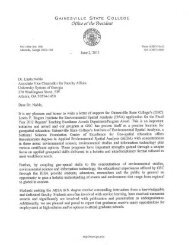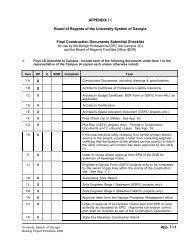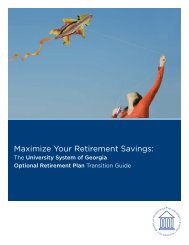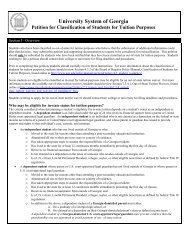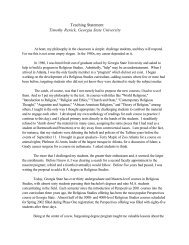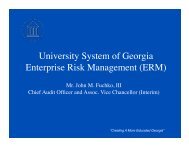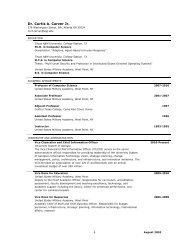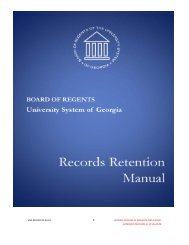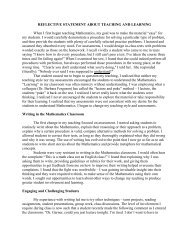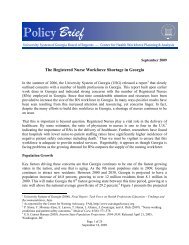66836 Federal Register / Vol. 75, No. 209 / Friday, October 29, 2010 / Rules and RegulationsWReier-Aviles on DSKGBLS3C1PROD with RULES2conveyed to prospective students. Topromote the goal <strong>of</strong> facilitating informedchoice, the disclosure must be simpleand meaningful.The <strong>Department</strong> intends to develop inthe future a disclosure form and will beseeking public comment about thedesign <strong>of</strong> the form through theinformation collection process underthe Paperwork Reduction Act <strong>of</strong> 1995(PRA). While the form will bedeveloped through that process, theregulations require institutions toprovide clear and prominent notice,delivered to students at appropriatetimes and in promotional materialsprior to enrollment. Until a form isdeveloped and approved under the PRAprocess, institutions must comply withthese disclosure requirementsindependently. In addition, we agreewith the comments that disclosuresalone are likely to be inadequate andhave proposed to establish programperformance standards in our NPRM onProgram Integrity—Gainful Employmentthat was published in the FederalRegister on July 26, 2010 (75 FR 43616).Changes: Section 668.6(b) has beenrevised to provide that an institutionmust prominently provide theinformation it is required to discloseabout a program in a simple andmeaningful manner on the home page <strong>of</strong>its program Web site, and provideprominent and direct links to this pageon any other Web page containinggeneral, academic, or admissionsinformation about the program. Therevised provision also states that aninstitution must use the disclosure formdeveloped by the Secretary when itbecomes available and the disclosureinformation must be displayed on theinstitution’s Web site in an open formatthat can be retrieved, downloaded,indexed, and searched by commonlyuse Web search applications. An openformat is one that is platformindependent,is machine-readable, andis made available to the public withoutrestrictions that would impede the reuse<strong>of</strong> that information.Finally, § 668.6(b) has been revised toprovide that an institution must makethe information available in thepromotional materials conveyed toprospective students.Placement RatesComment: Many commenters objectedto using the placement rate calculationin § 668.8(g) arguing that it is overlyburdensome and administrativelycomplex. The commenters opined thattracking a student for 180 days aftergraduation for a period <strong>of</strong> 13 weeks wastoo long and believed that it would bevirtually impossible for the <strong>Department</strong>or any other auditor to affirm theaccuracy <strong>of</strong> the placement data becausethe tracking period represents nothingmore than a snap-shot <strong>of</strong> how manystudents were employed for 13 weeks atthe time the data was collected. Thecommenters asserted that if the<strong>Department</strong> requires placementinformation to be disclosed to students,the information that an institutioncurrently provides to its accreditingagency, which routinely assesses thatinformation, would be more accurate. Inaddition, the commenters wereconcerned about potential conflicts withthe misrepresentation provisions insubpart F <strong>of</strong> part 668 on the groundsthat any placement rate disclosed tostudents would be obsolete as soon asit was posted to an institution’s Website. Some <strong>of</strong> the same commentersobjected to the proposed alternative <strong>of</strong>relying on State-sponsored workforcedata systems arguing that there is noconsistency between the States thatmaintain employment outcome data,and that in many cases the datacollected fails to provide a full andaccurate depiction <strong>of</strong> the demand,growth, and earnings <strong>of</strong> keyoccupations.A number <strong>of</strong> commenters opposedusing the placement rate calculation in§ 668.8(g) arguing that it is a highlyrestrictive measure developed solely forextremely short programs <strong>of</strong>fered by afew institutions. The commenters notedthat an institution is already requiredunder § 668.41(d)(5) to disclose anyplacement rates it calculates and that itwould be confusing to students todisclose any additional rates beyondthose that it is required to calculateunder accrediting agency or Staterequirements. Some <strong>of</strong> thesecommenters suggested that in caseswhere an institution is not required byits accrediting agency to calculateplacement rates, the institution shouldcalculate the rates using a methodologyfrom a national accrediting agency orthe State in which the institution isauthorized to operate. Under either theagency or State methodology, thecommenters requested flexibility indetermining the rates for degreeprograms because employmentopportunities for graduates <strong>of</strong> degreeprograms are much more diverse thanfor graduates <strong>of</strong> occupationally specifictraining programs.One commenter stated that itsinstitution’s mission <strong>of</strong> educatingworking adults is at odds with theconcept <strong>of</strong> placement rates—many <strong>of</strong>the institution’s students are alreadyemployed and enroll to enhance theircareers through further education. Inaddition, the commenter stated that itVerDate Mar2010 14:10 Oct 28, 2010 Jkt 223001 PO 00000 Frm 00006 Fmt 4701 Sfmt 4700 E:\FR\FM\29OCR2.SGM 29OCR2would be impractical to administer a jobplacement regime for students takingonline programs who reside throughoutthe world. The commenterrecommended that placement rates becalculated in accordance with aninstitution’s accrediting agency or Staterequirements, but that the proposeddisclosures should not apply wherethere are no agency or Staterequirements. As an alternative, thecommenter suggested that regionallyaccredited institutions, which are notrequired to track employment outcomes,conduct post graduation surveys askingprogram graduates if they are working intheir field. An affirmative responsewould count as a ‘‘placement’’ even ifthe graduate maintained the sameemployment he or she had whileattending the institution. Along thesame lines, another commentersuggested that the <strong>Department</strong> allow aninstitution that is not required by anoutside agency to calculate placementrates, to develop and implement amethod that best reflects the make-up <strong>of</strong>its student body, including surveys,collecting employer documentation, orother methods.One commenter objected to using theplacement rate calculation intended forshort-term programs in § 668.8(g)because all <strong>of</strong> its programs were at orabove the baccalaureate level. While thecommenter stated that requiring publicdisclosure <strong>of</strong> relevant outcomes putspressure on an institution to ensure thatit is providing a good education to itsstudents, the commenter suggested thatunless an institution’s accreditingagency or State requires it to discloseplacement rates, the institution shouldonly disclose rates that it calculates onan annual basis for internal purposes orany employment or placementinformation it receives from surveyingits students. Another commenter madethe same suggestions and asked the<strong>Department</strong> to clarify that placementrates would only need to be updatedannually.Another commenter argued that theplacement rate methodology in§ 668.8(g) was never intended forgainful employment purposes and madeseveral recommendations including:(1) Excluding from the total number <strong>of</strong>students who completed a programduring an award year, the students whoare unable to seek employment due toa medical condition, active militaryduty, international status, continuingeducation, incarceration, or death. Inaddition, an institution could excludethose graduates who certify they are notseeking employment or those that it isunable to locate. The commenterspecified the documentation an
Federal Register / Vol. 75, No. 209 / Friday, October 29, 2010 / Rules and Regulations66837WReier-Aviles on DSKGBLS3C1PROD with RULES2institution would have to obtain foreach <strong>of</strong> these exclusions.(2) Removing the requirement in§ 668.8(g)(1)(iii) that a student must beemployed, or have been employed, for13 weeks and allowing students to findemployment within 6 months from thelast graduation date in the award year.(3) Replacing the employercertification, income tax form, andSocial Security provisions in§ 668.8(g)(3) with other ways that aninstitution would verify that a studentobtained gainful employment.Several commenters suggested usingthe methodology developed by anational accrediting agency because theproposed method in § 668.8(g) does nottake into consideration circumstancesthat would prevent graduates fromseeking employment, such as healthissues, military deployment orcontinuing education, or practical issuesrelated to the employment <strong>of</strong>international or foreign students.Several commenters stated it wouldbe difficult, if not impossible, for theseinstitutions to obtain the data needed tocalculate placement rates. Some <strong>of</strong> thesecommenters supported the use <strong>of</strong> Statesponsoredworkforce data systems, butcautioned that many communitycolleges would not be able to obtainsufficiently detailed placementinformation through data matches withthese systems to satisfy the proposedrequirements. Other commenters notedthat some States do not have workforcedata systems, so institutions in thoseStates would have to use the nonpreferred placement rate methodologyunder § 668.8(g). Many <strong>of</strong> thecommenters believed the requirement todocument employment on a case-bycasebasis under § 668.8(g)(2) would beoverly burdensome and labor intensive.Others opined that the placementprovisions are counterproductive,claiming that a substantial number <strong>of</strong>community colleges eschewedparticipating in programs under theWorkforce Investment Act because <strong>of</strong>placement rate requirements. On theother hand, another commentersupported the placement rate provisionsand recommended that all institutionsin a State participate in a workforce datasystem, if the State has one. Thecommenter asked the <strong>Department</strong> toclarify how the data obtained from aworkforce data system would be used tomeet the placement rate requirementsand the timeline for reporting thoserates. In addition, the commentersuggested revising the placement rateprovisions in § 668.8(g) to more closelyalign those provisions with practicesused by State data systems.One commenter stated that in order toreceive Federal funding under the CarlD. Perkins Career and Technical<strong>Education</strong> Act, a program must receiveState approval that entails a review <strong>of</strong>documentation requiring that theprogram be high demand, high wage orin an emerging field. As part <strong>of</strong> the Statereview, the institution providesdocumentation <strong>of</strong> potential placement.The commenter recommended that the<strong>Department</strong> waive the gainfulemployment provisions for allcertificate programs approved by theState under this review process.A commenter supported disclosingplacement rate data, but noted that theinstitution would only be able to reporton graduates who are employed in theState or continued their education. Theinstitution would not be able to provideoccupationally specific placement data,or data about graduates who findemployment outside the State, becausethe State’s labor data base only tracks (1)the type <strong>of</strong> business a graduate isemployed by, not the occupation <strong>of</strong> thegraduate, and (2) graduates who areemployed in the State.Several other commenters supportedthe proposed placement ratedisclosures, but believed that theprovisions in § 668.8(g) wereinadequate. The commenters madeseveral suggestions, including:(1) Expanding the category <strong>of</strong> studentswho complete a program (currently in§ 668.8(g)(1)(i)) to include students whoare eligible for a degree or certificate.The commenters stated they are aware<strong>of</strong> institutions that delay providing thedegree or certificate to students, whichomits these students from the placementrate calculation.(2) Specifying that the time standardsin § 668.8(g) (employment within 180days <strong>of</strong> completing a program andemployment for 13 weeks) also apply torates calculated from State workforcedata systems.(3) Specifying that employment mustbe paid. The commenters stated they areaware <strong>of</strong> institutions that have countedstudents in unpaid internships as beingemployed.(4) To be counted in the placementrate, providing that a student must findemployment in one <strong>of</strong> the SOC codesidentified for the program unless thestudent finds a job that pays more thanany <strong>of</strong> the identified SOC codes. Thecommenters believed that someinstitutions stretch the concept <strong>of</strong> a‘‘related’’ comparable job as currentlyprovided in § 668.8(g)(1)(ii). Forexample, an institution might includeany job at a hospital, including thelowest paying jobs, when the studentwas trained for a skilled job such as anVerDate Mar2010 14:10 Oct 28, 2010 Jkt 223001 PO 00000 Frm 00007 Fmt 4701 Sfmt 4700 E:\FR\FM\29OCR2.SGM 29OCR2x-ray technician. The higher earningsrecommendation would condition asuccessful placement but allow aninstitution to count a student employedin an unrelated SOC.(5) To address the situation where astudent cannot qualify for employmentuntil he or she passes a licensing orcertification examination, providing thatthe 180-day period during which thestudent would otherwise have to findemployment should start after theresults <strong>of</strong> the examination are available.(6) To be counted in the placementrate, specifying that a student mustwork for at least 32 hours per week. Thecommenters stated that they are aware<strong>of</strong> institutions that include as successfulplacements any student that works atany time during a week, even if it isonly for a few hours per week.(7) Specifying that institutions mustuse a State data system if it is availableto ensure accurate reporting.(8) If the institution chooses todemonstrate placement rates by salary,providing that documentation mustinclude signed copies <strong>of</strong> tax returns,W–4s or paystubs to document earnings.(9) To more thoroughly substantiateplacement rates, requiring the auditorwho performs the institution’scompliance audit under § 668.23 todirectly contact former students andemployers whose statements wereobtained by the institution.Discussion: We are persuaded by thecomments that using the methodologyin § 668.8(g) may not be the mostappropriate method for determining theplacement rate for the majority <strong>of</strong> theprograms that are subject to the gainfulemployment provisions. Moreover, inview <strong>of</strong> the varied suggestions for howthe rate should be calculated,documented, and verified, in early 2011we will begin the process for developingthe method to calculate placement ratesfor institutions through the NationalCenter for <strong>Education</strong> Statistics (NCES).These final regulations establish somereporting requirements using existingplacement data as explained below,with a transition in a later period forinstitutions to disclose placement ratesobtained from the NCES methodology.NCES will develop a placement ratemethodology and the processesnecessary for determining anddocumenting student employment andreporting placement data to the<strong>Department</strong> using the Integrated<strong>Postsecondary</strong> <strong>Education</strong> Data System(IPEDS).NCES employs a collaborative processthat affords the public significantopportunities to participate in making,and commenting on, potential changesto IPEDS. Potential changes are
- Page 1 and 2: Friday,October 29, 2010Part IIDepar
- Page 3 and 4: Federal Register / Vol. 75, No. 209
- Page 8 and 9: 66838 Federal Register / Vol. 75, N
- Page 10 and 11: WReier-Aviles on DSKGBLS3C1PROD wit
- Page 12 and 13: 66842 Federal Register / Vol. 75, N
- Page 14 and 15: 66844 Federal Register / Vol. 75, N
- Page 16 and 17: WReier-Aviles on DSKGBLS3C1PROD wit
- Page 18 and 19: 66848 Federal Register / Vol. 75, N
- Page 20 and 21: 66850 Federal Register / Vol. 75, N
- Page 22 and 23: WReier-Aviles on DSKGBLS3C1PROD wit
- Page 24 and 25: 66854 Federal Register / Vol. 75, N
- Page 26 and 27: WReier-Aviles on DSKGBLS3C1PROD wit
- Page 28 and 29: 66858 Federal Register / Vol. 75, N
- Page 30 and 31: 66860 Federal Register / Vol. 75, N
- Page 32 and 33: 66862 Federal Register / Vol. 75, N
- Page 34 and 35: 66864 Federal Register / Vol. 75, N
- Page 36 and 37: 66866 Federal Register / Vol. 75, N
- Page 38 and 39: WReier-Aviles on DSKGBLS3C1PROD wit
- Page 40 and 41: WReier-Aviles on DSKGBLS3C1PROD wit
- Page 42 and 43: 66872 Federal Register / Vol. 75, N
- Page 44 and 45: WReier-Aviles on DSKGBLS3C1PROD wit
- Page 46 and 47: WReier-Aviles on DSKGBLS3C1PROD wit
- Page 48 and 49: WReier-Aviles on DSKGBLS3C1PROD wit
- Page 50 and 51: 66880 Federal Register / Vol. 75, N
- Page 52 and 53: WReier-Aviles on DSKGBLS3C1PROD wit
- Page 54 and 55: 66884 Federal Register / Vol. 75, N
- Page 56 and 57:
66886 Federal Register / Vol. 75, N
- Page 58 and 59:
WReier-Aviles on DSKGBLS3C1PROD wit
- Page 60 and 61:
WReier-Aviles on DSKGBLS3C1PROD wit
- Page 62 and 63:
WReier-Aviles on DSKGBLS3C1PROD wit
- Page 64 and 65:
WReier-Aviles on DSKGBLS3C1PROD wit
- Page 66 and 67:
WReier-Aviles on DSKGBLS3C1PROD wit
- Page 68 and 69:
WReier-Aviles on DSKGBLS3C1PROD wit
- Page 70 and 71:
WReier-Aviles on DSKGBLS3C1PROD wit
- Page 72 and 73:
66902 Federal Register / Vol. 75, N
- Page 74 and 75:
WReier-Aviles on DSKGBLS3C1PROD wit
- Page 76 and 77:
WReier-Aviles on DSKGBLS3C1PROD wit
- Page 78 and 79:
66908 Federal Register / Vol. 75, N
- Page 80 and 81:
WReier-Aviles on DSKGBLS3C1PROD wit
- Page 82 and 83:
66912 Federal Register / Vol. 75, N
- Page 84 and 85:
WReier-Aviles on DSKGBLS3C1PROD wit
- Page 86 and 87:
66916 Federal Register / Vol. 75, N
- Page 88 and 89:
WReier-Aviles on DSKGBLS3C1PROD wit
- Page 90 and 91:
WReier-Aviles on DSKGBLS3C1PROD wit
- Page 92 and 93:
WReier-Aviles on DSKGBLS3C1PROD wit
- Page 94 and 95:
66924 Federal Register / Vol. 75, N
- Page 96 and 97:
WReier-Aviles on DSKGBLS3C1PROD wit
- Page 98 and 99:
66928 Federal Register / Vol. 75, N
- Page 100 and 101:
WReier-Aviles on DSKGBLS3C1PROD wit
- Page 102 and 103:
66932 Federal Register / Vol. 75, N
- Page 104 and 105:
WReier-Aviles on DSKGBLS3C1PROD wit
- Page 106 and 107:
66936 Federal Register / Vol. 75, N
- Page 108 and 109:
66938 Federal Register / Vol. 75, N
- Page 110 and 111:
66940 Federal Register / Vol. 75, N
- Page 112 and 113:
66942 Federal Register / Vol. 75, N
- Page 114 and 115:
66944 Federal Register / Vol. 75, N
- Page 116 and 117:
66946 Federal Register / Vol. 75, N
- Page 118 and 119:
WReier-Aviles on DSKGBLS3C1PROD wit
- Page 120 and 121:
WReier-Aviles on DSKGBLS3C1PROD wit
- Page 122 and 123:
WReier-Aviles on DSKGBLS3C1PROD wit
- Page 124 and 125:
66954 Federal Register / Vol. 75, N
- Page 126 and 127:
WReier-Aviles on DSKGBLS3C1PROD wit
- Page 128 and 129:
66958 Federal Register / Vol. 75, N
- Page 130 and 131:
66960 Federal Register / Vol. 75, N
- Page 132 and 133:
WReier-Aviles on DSKGBLS3C1PROD wit
- Page 134 and 135:
WReier-Aviles on DSKGBLS3C1PROD wit
- Page 136 and 137:
WReier-Aviles on DSKGBLS3C1PROD wit
- Page 138 and 139:
66968 Federal Register / Vol. 75, N
- Page 140 and 141:
66970 Federal Register / Vol. 75, N
- Page 142 and 143:
66972 Federal Register / Vol. 75, N
- Page 144 and 145:
66974 Federal Register / Vol. 75, N



